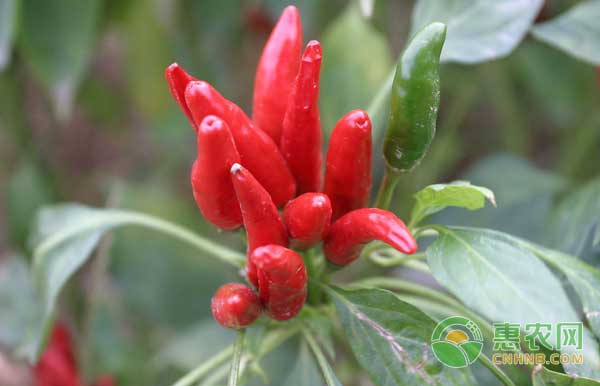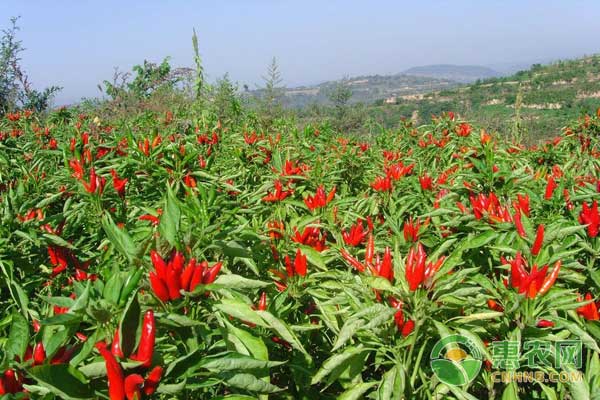When is pepper grown? Pepper growth habits and pest control programs
Capsicum has been cultivated in China for more than three hundred years. Different regions have different climatic conditions. The southern part is mainly planted with peppers, while the north is mainly planted with sweet peppers. The following small series says that pepper cultivation time and pest control Program.
Open field cultivation time and time arrangement : seedlings in southern China from December to January, planting from February to March; seedlings from mid to lower reaches of the Yangtze River from November to December, planting from March to April; seedlings from February to April in the northern region, 4 to Planted in May.
The growth cycle of pepper is divided into: germination stage, seedling stage, flowering fruit setting period and fruiting stage. Capsicum is a bisexual flower of the male and female flowers, self-pollination, short-flowered flowers are easy to pollinate and fertilized poorly, and long-flowered flowers should be cultivated.
The flower buds began to differentiate when the seedlings were 3-4 cm high and there were about 3 true leaves. The nutrient, water, light and temperature management during this period was very important.
The flower bud differentiation period is suitable for a daily temperature of about 25 ° C, a night temperature of 13 to 16 ° C, a ground temperature of 20 to 25 ° C, and sufficient organic matter, nitrogen, phosphorus and potassium micro-fertilizer.

First, the main disease of pepper seedlings
Capsicum ankle disease: The low temperature (15-160C) of the cotyledon seedling seedling bed is high in humidity and easy to occur. In the sowing period, the germ is brown and rot, the seeds are not germinated; after the seedlings are unearthed, the basal part of the cotyledon is water-stained, yellowish brown, with no obvious edges, gradually losing water and thinning, and finally falling down. White flocculent hyphae can be seen on the seedling bed. Use 30% carbendazim or nail cream Familia double seed bed spray, 2-3 times interval 5-7 days.
Capsicum blight: occurs mostly in the middle and late stages of seedlings. The base of the affected seedlings produces elliptical dark brown lesions, which are obviously sunken; the seedlings are wilting during the early days and recover at night; when the lesions circle around the stem, the stems of the shoots The contraction is dry and the leaves are wilting. Blight disease generally does not fall, when the humidity is high, the pale base of the stem can be seen in the base of the stem. Use nail cream or oxazolidine spray treatment to treat, you can also use the allicin + carbaryl root.
Viral disease: Due to the different types of viruses, the symptoms are different. Generally, there are symptoms such as mosaic, fern leaf, Ming pulse, dwarf, yellowing, necrosis and apical. The virus that harms China's pepper is cucumber mosaic virus and tobacco mosaic virus, and the virus disease mainly spreads by aphids. Pepper varieties are more resistant than sweet pepper varieties. The viral disease is mainly treated with amino oligosaccharide or morpholinium hydrochloride + imidacloprid + zinc fertilizer, and a package of pure milk is better.

Second, the main disease of pepper in adult stage
Bacterial diseases: scab, soft rot
Fungal diseases: blight, anthracnose, leaf mold, root rot
Viral disease: tobacco mosaic virus / cucumber mosaic virus
Bacterial scab
Harmful parts: damage to leaves and stems, water spots on the spots, small spots, dark green edges, light depression in the middle
Popular time: July to August, severe heat and rainy season
Control technology: 72% agricultural streptomycin or chrysanthemum or quinoline copper in the early stage of the disease
Bacterial soft rot
Harmful parts: harming the fruit, the rot of the victim is stinky, it seems to have muddy water, and the dry fruit is white and dry in the later stage.
Popular time: July to September, high temperature, rain, high humidity, serious
Control technology: 50% chlorobromoisocyanuric acid can be sprayed at the beginning of the disease
Downy mildew
Harmful parts: stems, leaves, branches, fruits can be infected
Symptoms: Dark green water stains, the disease is obviously contracted, and white sparse mildew can be seen in the diseased part.
Control technology: enoyl manganese zinc or cymoxanil / creamer
anthrax
Harmful parts: fruit, leaves
Symptoms: The lesions are initially water-soaked with yellow-brown spots, with raised concentric circles, and light red viscous when wet.
Control technology: difenoconazole or prochloraz
Leaf mold
Harmful part: blade
Symptoms: yellow patches on the front of the leaves and mildew on the back
Control technology: manganese zinc flusilazole or myclobutanil
Viral disease
Harmful parts: leaves and branches
Symptoms: leaf shrinkage, yellow flower, deformity
Control technology: amino oligosaccharide or morpholinium hydrochloride + imidacloprid + zinc fertilizer
Fusarium wilt
Harmful part: occurs in the root and stem of the fruiting stage
Symptoms: The plants are wilting, the vascular bundles are brown, rot, and finally the plants die. Flooded land
Control technology: Shensinmycin / Chunleimycin + carbendazim
Gray mold
Harmful parts: leaves, stems, branches, flowers, fruits
Symptoms: The affected part is brown, water-immersed, and there is a gray mold layer.
Control technology: Isocarbazide
Chalk disease
Injurious parts: stems, roots
Symptoms: The diseased part was brown with water immersion, white silk on the surface, and brown sclerotia in the late stage of plant wilting. There are many in the north.
Control technology: chlorin or chlorobromoisocyanuric acid
powdery mildew
Harmful parts: only blades
Symptoms: a piece of white powdery mildew is formed between the branches of the back of the blade, and finally the leaves are yellow.
Control technology: azoxystrobin or ether phenol

Third, the prevention and control of pepper root knot nematode
Capsicum annuum mainly affects the roots of peppers, forming symptoms such as tumor-like root knots and rotten roots, which cause the growth of the capsicum peppers to gradually die. The warm and humid environment in southern China is conducive to nematodes. In the north, the sturdy (sweet) peppers are planted in the sheds, and the root-worm disease is more serious. Especially in the wintering area where the spicy (sweet) pepper is cultivated, the continuous cropping of the pepper, the rootworm disease is common, which has seriously affected the production of spicy (sweet) pepper.
The root-knot nematode of capsicum is currently mainly used with avermectin or thiazolidine granules, but it has developed resistance in severe plots. Bacillus subtilis can now be used to treat the soil before planting, and in severe cases thiazolidine is used to increase the application of the allicin.
The above are common diseases and control measures during pepper planting, and the contents are for reference only. If you want to know more about agricultural technology, please pay attention to the Hui Nong School!
YT-H008
YT-H008
Shenzhen Sunshine Technology Co.,Ltd , https://www.shenzhenyatwin.com